The history of yeovil
Lords of yeovil
The Conqueror's followers, Rectors, Nuns and the Gentry
|
|
|
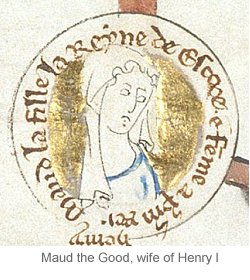 Introduction
Introduction
The story of who held power in Yeovil is a somewhat convoluted tale chiefly because Yeovil, until relatively recent times, comprised three different major elements; The Borough of Yeovil, the Manor of Hendford and the Manor of Kingston. Additionally the former Manor of Lyde has been absorbed into Yeovil as well as the tithings of Preston Plucknett and Preston Bermondsey. Further, the tithings of Wigdon and Huntley wholly in the parish of Yeovil and partly in the Manor of Kingston later became Marsh, which still remains within the parish of Yeovil. The tithing of Houndstone and the Manor of Newton Surmaville were also later included. Not only that, the titles of the various holdings have changed through time; even in 1820 the Yeovil solicitor Edmund Batten, in giving evidence at a Charity Commissioners enquiry stated "The parish is divided into three tithings, viz. the Borough tithing, Wigdon and Huntley tithing, and Henford tithing; the Borough tithing is that which belongs to Mr. Phelips, as lord of 'the manor and borough. I am steward of Mr. Prowse, the lord of the manor of Kingston juxta Yeovil, within the tithing of Wigdon and Huntley, which adjoins the borough tithing."
After the Conquest, King William gave the manors of Yeovil to Robert, Count of Mortain and William, Count of Eu. The manor that was to become Kingston was held by tenant-in-chief Robert, Count of Mortain and half-brother to William the Conqueror. Robert also held Houndstone. William, Count of Eu was tenant-in-chief to that part of Yeovil that would become Hendford manor as well as part of Preston Plucknett. Further, at this time, the twenty two messuages that were to become known as 'The Tenement' and the future Borough of Yeovil, was actually within William d'Eu's holdings.
William d'Eu, however, was not to remain tenant-in-chief for very long. In 1088, after the death of William the Conqueror the previous year, he rebelled and conspired with Robert de Mowbray, Roger de Lacy and William of Aldrie to murder William II and install the king's cousin, Stephen of Aumarle. In January 1096 William d’Eu was formally accused and challenged to trial by combat at Salisbury. He was defeated and executed. All his lands, including his Yeovil holdings, reverted to the crown although Hugh Maltravers remained under-tenant at Yeovil.
In the meantime, towards the end of the 11th century William of Mortain, the son of Count Robert of Mortain, gave the church at Montacute and his castle, burgh, market and the manor of 'Biscopestune' with its hundred and mill, to the abbey of Cluny. The first charter in the Montacute Cartulary, belonging to the period between 1091and 1104, was signed by King Henry I and one of the witnesses was Hugh Maltravers.
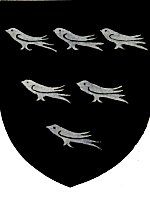 However in 1104
William of
Mortain, who
took part in the
unsuccessful
rising against
William Rufus, by
this time had
succeeded his
father as
tenant-in-chief
of his Yeovil
lands. He was
banished by
Henry I and
these lands, the
future Manor of
Kingston
reverted to the
crown. William
was forced to
become a monk at
the
newly-established Cluniac priory
at Bermondsey.
However in 1104
William of
Mortain, who
took part in the
unsuccessful
rising against
William Rufus, by
this time had
succeeded his
father as
tenant-in-chief
of his Yeovil
lands. He was
banished by
Henry I and
these lands, the
future Manor of
Kingston
reverted to the
crown. William
was forced to
become a monk at
the
newly-established Cluniac priory
at Bermondsey.
The arms of Bermondsey Priory were - per pale gules and azure, a bordure argent (a divided field of red and blue with a silver border).
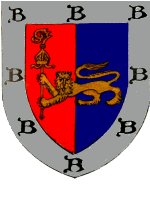 The
Monks of
Bermondsey were
to maintain two
chaplains to
serve Preston
Bermondsey
chapel. Ansger's
son, Walter,
added two hides
at Stone, which
became the
detached portion
of the parish. The
post-1399 arms
of Bermondsey
Priory were -
per pale gules
and azure, over
all a lion
passant guardant
holding a
pastoral staff enfiled with a
mitre or, a
bordure argent
charged with
eight letters B,
argent (a
divided field of
red and blue
with a golden
walking lion,
his head facing,
holding a
crozier piercing
a mitre. A
silver border
with eight
letters B).
The
Monks of
Bermondsey were
to maintain two
chaplains to
serve Preston
Bermondsey
chapel. Ansger's
son, Walter,
added two hides
at Stone, which
became the
detached portion
of the parish. The
post-1399 arms
of Bermondsey
Priory were -
per pale gules
and azure, over
all a lion
passant guardant
holding a
pastoral staff enfiled with a
mitre or, a
bordure argent
charged with
eight letters B,
argent (a
divided field of
red and blue
with a golden
walking lion,
his head facing,
holding a
crozier piercing
a mitre. A
silver border
with eight
letters B).
Henry I (c1068-1135), was the fourth son of William the Conqueror. On William's death in 1087, Henry's older brothers William Rufus and Robert Curthose inherited England and Normandy respectively, but Henry was left landless. Henry allied himself with William against Robert and was present when William died in a hunting accident in 1100, he immediately seized the English treasury and crown. Henry married Edith (c1080-1118), daughter of Malcolm I, King of Scotland, on 11 November 1100, and on her marriage she took the Norman name of Matilda or Maud and became known as 'Maud the Good'.
Following her marriage Maud was bestowed with lands of her own including the 'tenement' of Yeovil, that is the town of Yeovil, which she placed under the Church of St John the Baptist. This resulted in the Rectors of St John's becoming Lords of the Borough. However, since the Borough was actually within the manor of Hendford, it meant that the people of the Borough had two lords; the Rector and the Lord of the Manor of Hendford, the title retained by the Maltravers family as under-tenants even after the fall of d'Eu.
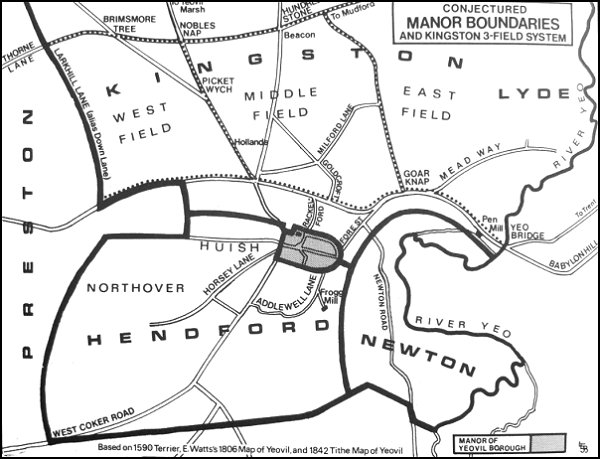
This superb map by Leslie Brooke shows the approximate boundaries of the Yeovil manors.
The Borough of Yeovil
By 1305 the original twenty two messuages of the 'Tenement' had become a free borough. With this came certain rights such as the right to elect burgesses and, with the veto of the lord of the manor, a provost. The original Borough of Yeovil was a relatively tiny part of today's town that grew up around St John's church and the boundary of the borough ran along what is now North Lane to Silver Street then followed the Rackle brook towards Vennell's Cross, now the Triangle, continuing along South Street to Hendford then running north as far as Church Lane then turning north again to rejoin North Lane.
The advowson of St John's was finally separated from Hendford Manor in 1334 and from 1339 it was granted absolutely to John Maltravers. The advowson remained with the Maltravers until the line ended with his granddaughters and coheirs, Joan and Eleanor, at his death in 1350. At the death of Joan without issue, Eleanor became de jure Baroness Maltravers. She was the wife of John Fitz Alan, a younger son of the Earl of Arundel. As a consequence the advowson of Yeovil passed to the Arundels.
From this time onwards, until 1415, the Arundels presented rectors to the benefice as it became vacant. In 1415 Thomas, the 13th Earl of Arundel, sold the lordship and advowson to Henry V (reigned 1413-1422) although he kept the Manor of Hendford.
In this same year of 1415 King Henry V was victorious over the French at Agincourt, following which the king personally laid the foundation stone of the Convent of Syon at Isleworth, Middlesex. In 1420, in order to part-support the convent, Henry granted them the rectory and lordship of the Borough of Yeovil together with ‘two acres of land in Huish and a portion in Martock’. The Borough of Yeovil was just one of the many scattered possessions bestowed on the Convent.
For the next 114 years, until the Dissolution of the Monasteries in 1534 by Henry VIII, Yeovil came under the jurisdiction of the Abbess and was administered locally by a resident bailiff working in conjunction with the Portreeve and Burgesses. In 1534 Henry VIII granted the manor and church of Yeovil to Catherine Parr.
In 1538 Sir John Horsey of Clifton Maybank, just south of Yeovil, bought the lease of the lordship and parsonage of Yeovil for an annual fee to the Crown of £45. He was succeeded by his son, also Sir John Horsey, in 1546. The Horsey family, after whom Horsey Lane is most likely named, retained the lordship and advowson until 1610.
They sold the lordship in 1610 to George and Thomas Whitmore of London. The Whitmores however sold the lordship a year later to Sir Edward Phelips, builder of Montacute House, Master of the Rolls and Speaker of the House of Commons.
The Phelips family retained the lordship until 1846 when William Phelips, on reaching his majority, sold it to George Harbin of Newton Surmaville for the Corporation. Harbin was not to be Lord of Yeovil for long since in 1854 an Act of Parliament gave municipal status to Yeovil and the lordship was assumed by the new Mayor and Corporation, thus ending nearly eight hundred years of feudal rule.
The Manor of Hendford
As noted above, Hendford was retained by the Maltravers family as under-tenants even after the fall of d'Eu. Hugh Maltravers, the original Hendford under-tenant of William d'Eu, also held of Alured de Ispania "three hides and a half, less by a virgate, at Prestetone; and it was probably this Hugh Maltravers who gave lands in Preston, Somerset, to the monks of Montacute, which gift was confirmed by charter of Henry II."
There are few other mentions of Maltravers connected with Hendford but Walter Maltravers was required in 1335 to show by what right he held Preston and Gyvele and in 1349 "As Rector of Yevely he acquired 4 messuages and 54 acres of land of Roger Bak in Preston Plekenet, and Hyneford, Somerset, 22 Edw. III."
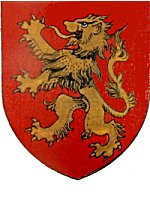 John Maltravers
granddaughter
married John
Fitz Alan, a
younger son of
the Earl of
Arundel. As a
consequence the
advowson of
Yeovil passed to
the Arundels. As
seen above, in
1415 Thomas, the
13th Earl of
Arundel, sold
the lordship and
advowson to
Henry V but kept
the Manor of
Hendford. The
Arundels kept
the manor of
Hendford until
Henry Fitzalan
(1512-1580),
19th Earl of
Arundel,
exchanged it
with Queen
Elizabeth in
1561. At left
are the arms of
Fitzalan, Earls
of Arundel -
gules, a lion
rampant or (a
golden standing
lion on a red
ground).
John Maltravers
granddaughter
married John
Fitz Alan, a
younger son of
the Earl of
Arundel. As a
consequence the
advowson of
Yeovil passed to
the Arundels. As
seen above, in
1415 Thomas, the
13th Earl of
Arundel, sold
the lordship and
advowson to
Henry V but kept
the Manor of
Hendford. The
Arundels kept
the manor of
Hendford until
Henry Fitzalan
(1512-1580),
19th Earl of
Arundel,
exchanged it
with Queen
Elizabeth in
1561. At left
are the arms of
Fitzalan, Earls
of Arundel -
gules, a lion
rampant or (a
golden standing
lion on a red
ground).
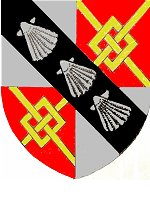 Sir
John Spencer,
who had been
Lord Mayor of
London in 1594,
acquired the
Manor of
Hendford from
Elizabeth I in
1599. On his
death in 1633
the manor passed
to his daughter
Elizabeth, wife
of William,
second Lord
Compton. The
Spencer arms
were
quarterly argent
and gules, in
the second and
third a fret or,
overall a bend
sable charged
with three
escallops of the
first (on a
quartered field
of silver and
red, with a
golden fret in
the second and
third, a black
diagonal band
with three
silver
scallops).
Sir
John Spencer,
who had been
Lord Mayor of
London in 1594,
acquired the
Manor of
Hendford from
Elizabeth I in
1599. On his
death in 1633
the manor passed
to his daughter
Elizabeth, wife
of William,
second Lord
Compton. The
Spencer arms
were
quarterly argent
and gules, in
the second and
third a fret or,
overall a bend
sable charged
with three
escallops of the
first (on a
quartered field
of silver and
red, with a
golden fret in
the second and
third, a black
diagonal band
with three
silver
scallops).
Through his daughter, Elizabeth, the Manor of Hendford passed to her husband William Compton, 1st Earl of Northampton. After his death in 1630 Hendford was held by their son Spencer Compton (1601-1643), 2nd Earl of Northampton. The third Earl, James Compton (1622-1681) is known to have held the lordship in 1633 when he was involved in a lawsuit with several Yeovil townsmen, including a Richard Coxe, but after this date the ownership of the lordship is uncertain until 1715 when George Cox mentioned 'my manor of Hendford' in his will.
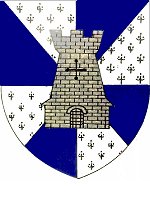 In
1761 James
Hooper purchased
the Manor of
Hendford. Burke's
'General Armory'
records these as
the arms of
Thomas Hooper of
Hendford. The
Hoopers lived in
Hendford Manor
until the 1830s.
The Hoopers were
long associated
with Yeovil;
Stephen Hooper
(d post 1452)
owned property
in Grope Lane
and another
Stephen gave the
9th and tenor
bells to St
John's church in
1626.
The arms of the
Hooper family were
gyronny of
eight ermine and
azure, over all
a tower argent
(on a field
of eight
triangles of
ermine and blue,
a silver tower).
In
1761 James
Hooper purchased
the Manor of
Hendford. Burke's
'General Armory'
records these as
the arms of
Thomas Hooper of
Hendford. The
Hoopers lived in
Hendford Manor
until the 1830s.
The Hoopers were
long associated
with Yeovil;
Stephen Hooper
(d post 1452)
owned property
in Grope Lane
and another
Stephen gave the
9th and tenor
bells to St
John's church in
1626.
The arms of the
Hooper family were
gyronny of
eight ermine and
azure, over all
a tower argent
(on a field
of eight
triangles of
ermine and blue,
a silver tower).
James Hooper died in 1790 without issue and Hendford passed to his nephew, Jonathan. In turn the manor passed to Jonathan's son, the Reverend James Hooper who sold it in 1840 to solicitor Edwin Newman.
The Manor of Kingston
Kingston may well have derived its name from the fact that before the Conquest it had been held by the Royal Family of Wessex, including King Alfred, and was therefore known as the king's "tun" or village.
Again, as seen above, in 1104 William Count of Mortain was banished by Henry I and his lands, including the future Manor of Kingston, reverted to the crown. Following this reversion, the earliest known lord of what would become Kingston manor was Hugh de Say of Richard's Castle, Herefordshire. He was probably born sometime around 1120 and was the second son of Hugh fitz Osbern and Eustachia de Say. Hugh adopted his mother's surname during the long lifetime of his childless elder brother, Osbern fitz Hugh, who inherited the family lands on their father's death in the late 1130's. Hugh succeeded his brother in 1186, four years before his own death.
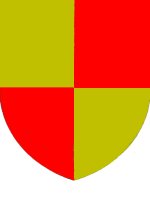 The
Manor of
Kingston was
held by the de
Say family soon
after the
Conquest. It
continued in
their possession
until the
thirteenth
century when the
inheritance
passed to two
daughters of
Richard de Say;
Edith who
married Thomas
de Huntley and
Matilda who
married Thomas
de Arderne.
The
Manor of
Kingston was
held by the de
Say family soon
after the
Conquest. It
continued in
their possession
until the
thirteenth
century when the
inheritance
passed to two
daughters of
Richard de Say;
Edith who
married Thomas
de Huntley and
Matilda who
married Thomas
de Arderne.
The arms were quarterly or and gules ( a quartered field of gold and red).
Hugh de Say married Lucy, the daughter of Walter de Clifford, and they had three sons; Hugh, Richard, and Gilbert. They also had a daughter Lucy (Complete Peerage, Volume 9, page 257, note i, states that Hugh and Lucy had a daughter Lucy, and cites "Montacute Cart, Somerset Record Society, nos 35, 36". It also states that she was probably married to Thomas de Arden, citing "Rotuli litterarum clausarum", vol i, p261).
Hugh's wife Lucy is known to have presented Thomas Maltravers to the chapel of All Saints, Kingston in 1177 and so it is likely that she brought Kingston to her marriage. "In 15 John 1214, at an assize, Gilbert de Say claimed of him the last presentation to the chapel of All Saints, Kingeston, Somerset, when the jury determined that Lucia, mother of Gilbert, presented last." Hugh himself died in or shortly before 1190, possibly whilst fighting in Wales. Following his death, his widow Lucy married Bartholomew de Mortimer.
Leslie Brooke wrote that "Lucius de Say succeeded to the manor in 1204. The son of Hugh and Lucy, and a minor, he was placed under the wardship of William Cantilupe of Trent". I can find no trace of any Lucius de Say in any of the many currently-available genealogies and wonder if this could have been the daughter, Lucy? In any event in 1205 Hugh and Lucy's third son, Gilbert, held the manor in trust for his ward, Margaret.
The following year, 1206, Nicholas de Say is recorded as lord of Kingston and he was succeeded by Richard de Say in 1221. Richard died without issue and was succeeded by his brother Gilbert in 1226 who died that same year. The manor then passed to two sisters; Matilda who inherited Kingston and the tithing of east Marsh and Edith who took 'La Marshe', or the tithing of west Marsh. Matilda was the wife of Thomas de Arderne who therefore became lord of Kingston. Edith was married to Thomas de Huntele.
In 1283 it was recorded that Thomas de Huntley held West Marsh, from Robert de Mortimer of Richard's Castle in Hereford, and Walter de Wigdon held Kingston and East Marsh from Robert de Mortimer. The tithings of West Marsh and East Marsh were known as Wigdon and Huntley until the middle of the nineteenth century when they became Yeovil Marsh.
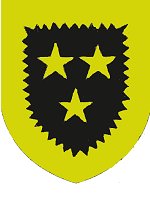 Walter
de Wigton was in
possession of
the Manor of
Kingston during
the reign of
Edward I. He
died in 1286 and
the estate was
inherited by his
22-year old son,
John. The name,
as Wigdon,
survived as the
designation
given to East
Marsh. The arms
of Wigton were
sable, three
mullets and a
bordure indented
or (on a
black field with
a golden
indented border,
three golden
stars
representing
rowels of
spurs).
Walter
de Wigton was in
possession of
the Manor of
Kingston during
the reign of
Edward I. He
died in 1286 and
the estate was
inherited by his
22-year old son,
John. The name,
as Wigdon,
survived as the
designation
given to East
Marsh. The arms
of Wigton were
sable, three
mullets and a
bordure indented
or (on a
black field with
a golden
indented border,
three golden
stars
representing
rowels of
spurs).
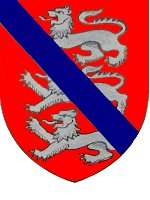 In 1307 John
de Wigdon, son
of Walter, sold
Kingston to Sir
Robert Fitzpaine,
who also held
Lyde. Kingston
passed to Sir
Robert's son,
also Robert, who
settled it on
his daughter
Isabella in
1344. Kingston
passed
from the Fitzpaines to
the Chideocks in
1344 when Isabella
was married to
John de Chydiok
and Kingston was
then held by
five further
generations of
Chydioks, all
called John. The
Fitzpaine arms
were gules,
three lions
passant in pale
argent,
debruised by a
bend azure
(on a red
ground, three
silver lions
walking past,
beneath one
another with a
blue stripe over
them).
In 1307 John
de Wigdon, son
of Walter, sold
Kingston to Sir
Robert Fitzpaine,
who also held
Lyde. Kingston
passed to Sir
Robert's son,
also Robert, who
settled it on
his daughter
Isabella in
1344. Kingston
passed
from the Fitzpaines to
the Chideocks in
1344 when Isabella
was married to
John de Chydiok
and Kingston was
then held by
five further
generations of
Chydioks, all
called John. The
Fitzpaine arms
were gules,
three lions
passant in pale
argent,
debruised by a
bend azure
(on a red
ground, three
silver lions
walking past,
beneath one
another with a
blue stripe over
them).
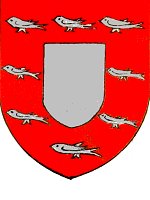 The
manor and
advowson of the
Rectory of
Kingston came to
the Chideocks by
Isabella, daughter of
Robert Fitzpaine ,
but passing
to the Holland
family, Earls of
Kent, towards
the end of the
reign of Richard
the Second.
The
manor and
advowson of the
Rectory of
Kingston came to
the Chideocks by
Isabella, daughter of
Robert Fitzpaine ,
but passing
to the Holland
family, Earls of
Kent, towards
the end of the
reign of Richard
the Second.
The Chideock arms were gules, an escutcheon and an orle of martlets argent (on a red ground, a silver shield and a border of silver martlets - birds like swallows with thighs but no visible legs).
Collinson wrote in 1791 "Kingston juxta Yeovil, sometimes called Kingston-Pitney, with the advowson of the free chapel there, valued at 100s per annum. From the family of de Wigetone it came to the Fitzpaines, who held it by the service of half a knight's fee. 30 Edw. III (1357) John Fawconer, of West-Marsh, released to William son and heir of William de Carent, then under age and in ward to the King, all his right in the manors of Kingston juxta Yeovil, and Hunteleghe-Marsh."
In 1387 John Chydiok mortgaged Kingston to Thomas de Holland (1350?-1397), 2nd Earl of Kent and half-brother of King Richard II. in 1401 it passed to Thomas' widow, Alice Holland, Countess of Kent. The Holland association with Kingston remains to this day with the area known as Hollands, now occupied by Yeovil College.
By 1411 Kingston had reverted back to the ownership of John Chidiock. One of his daughters, Margaret, married William Stourton, 2nd Baron Stourton, and Kingston passed into the Stourton family for the next twelve generations. There are various references such as in 1501 "16 Henry VII by William Lord Stourton" and in 1580 "22 Eliz. John Lord Stourton held the manor and the advowson of the chapel of Kingston juxta Yeovil". Collinson referred to Kingston Pitney chapel "In that part of Kingston, which is now called Kingston-street, stood the chapel, to which the sinecure of Pitney is annexed, and where the rector reads prayers after institution. The Rev, Dr. Hunt is the present incumbent of the living of Kingston alias Pitney."
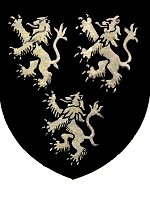 The
earliest known
member of the
Prowse family,
recorded on a
brass on the
floor of the
chancel of St
John's church,
is George Prowse
who died in
1624. The
family's main
residence was in
Kingston. John
Prowse bought
the manor house
in 1710.
The
earliest known
member of the
Prowse family,
recorded on a
brass on the
floor of the
chancel of St
John's church,
is George Prowse
who died in
1624. The
family's main
residence was in
Kingston. John
Prowse bought
the manor house
in 1710.
The Prowse arms were sable, three lions rampant, argent (on a black field, three rearing silver lions).
By 1714 John Prowse was being described as the 'Landlord of the Manor of Kingston'. John Prowse died in 1722 but from 1719 his son George Prowse was described as 'Lord of the Manor of Kingston'. The Prowse family were Lords of the Manor of Kingston until the middle of the 19th century.
The Tithing of Preston Plucknett
In 1856 Vickery wrote "Preston is a considerable parish one mile northwest from Yeovil, in the turnpike-road to Taunton. It is divided into two tithings, viz. 1. Preston-Plucknet, containing forty houses, with the church, 2. Preston-Bermondsey, containing fourteen houses. The whole number is fifty-four, and of inhabitants two hundred and eighty. There are about ten farms ; the rest are mostly cottages, but better than in many other parishes. The soil is a rich light sandy loam, and stone-rush, with good blue marle under it, and the situation very pleasant. It is highly cultivated, well watered by springs, and ornamented, but not encumbered with wood."
The western part of today's Preston Plucknett was included in the 'Ivle' of William d'Eu described in the first entry of the Domesday Book described here. At this time the under-tenant was Hugh Maltravers whose descendants sold this part of their holdings to William of Haselbere in 1150. He died in 1166 and was succeeded by his son, also William. His son Richard inherited the holdings in turn but he revolted against King John (reigned 1199-1216) and was executed at Sherborne Castle.
John Marshall, the Custos of Sherborne Castle and nephew of the Earl of Pembroke, seized all of Richard of Haselbury's estates, including Preston, in the name of the king. The king later granted the lands to Marshall and they passed to his son, William, on his death. William Marshall was a follower of Simon de Montfort, 6th Earl of Leicester and a powerful baron who lead a revolt against Henry III. As a result Marshall's lands were forfeited and in 1270 the king granted them to Sir Alan Plugenet (or Ploknet) who added his name to Preston which, through time, has become Preston Plucknett.
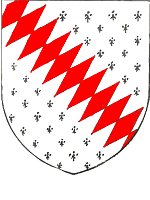 The
arms of Plugenet
were ermine,
a bend fusilly
gules (on a
field of the fur
ermine, a red
diagonal stripe
made of lozenge
shapes).
The
arms of Plugenet
were ermine,
a bend fusilly
gules (on a
field of the fur
ermine, a red
diagonal stripe
made of lozenge
shapes).
Sir Alan's son, another Sir Alan Plugenet, was excommunicated in 1315 for having refused to bury his mother according to her wishes and also for assaulting the Rural Dean of Sherborne and forcing him to eat the deed of citation. He was later pardoned. After his death in 1326 his sister, Joan, inherited his lands which she sold to John de Preston.
In 1354 John de Preston died and his son, also John, inherited his fathers' holdings. This John held Preston "by the service of the third part of one knight's fee". He died in 1362 and was succeeded by his daughter Elizabeth de Pappeworthe. She, however, died within ten days and the estate was then held by her six aunts with William de Pappeworthe as tenant. "To him succeeded another John de Preston, who 10 Ric. II (1387) gave a lease of lands in Preston-Plucknet to Felicia the widow of Roger Warmewell."
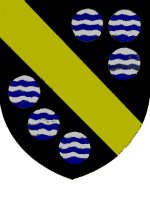 Sir
John Stourton of
Preston
Plucknett left
40 shillings to
the fabric of
the church of
Yeovil in 1438.
As well as
Preston, he
owned Brympton
and Pendomer,
and was uncle of
the first Lord
Stourton. Of his
three daughters,
Joan took
Brympton to John
Sydenham, Cicely
took Preston to
John Hill and
Alice took
Pendomer to
William Daubeny.
The arms of
Stourton were
sable, a
bend or between
six fountains
(on a black
field, a golden
diagonal stripe
between the
representation
of six
fountains).
Sir
John Stourton of
Preston
Plucknett left
40 shillings to
the fabric of
the church of
Yeovil in 1438.
As well as
Preston, he
owned Brympton
and Pendomer,
and was uncle of
the first Lord
Stourton. Of his
three daughters,
Joan took
Brympton to John
Sydenham, Cicely
took Preston to
John Hill and
Alice took
Pendomer to
William Daubeny.
The arms of
Stourton were
sable, a
bend or between
six fountains
(on a black
field, a golden
diagonal stripe
between the
representation
of six
fountains).
"In 1380 John de Stourton acquired Preston Plucknett, to be followed by his son, yet another John, whose daughter, Cecily, married first John Hill of Spaxton and then, after his death, Sir Thomas Keriel. Her son, John, by her first marriage, inherited in in 1452 and was followed by his son, another john Hill, in 1474. When the latter died in 1474, his daughter Genevieve, being a minor, was made a ward of the king. She later married William Say (afterwards Sir William) who held Preston Plucknett in 1480, to be followed by joint holders, yet again, this time his four cousins, one of whom was John Waldegrave." (Brookes, 1978).
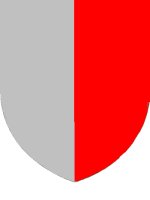 The
Manor of Preston
Plucknett was
shared by four
cousins
following the
death of Sir
William Say in
1529, one of
whom was John
Waldegrave. By
1599 he had
acquired the
whole of his
cousins'
holdings. He
settled it on
the marriage of
his eldest son,
Edward, with
Elinor Lovell
and it continued
in the
Waldegrave
family until it
was sold to
Edward Phelips
in 1725.
The
Manor of Preston
Plucknett was
shared by four
cousins
following the
death of Sir
William Say in
1529, one of
whom was John
Waldegrave. By
1599 he had
acquired the
whole of his
cousins'
holdings. He
settled it on
the marriage of
his eldest son,
Edward, with
Elinor Lovell
and it continued
in the
Waldegrave
family until it
was sold to
Edward Phelips
in 1725.
The arms were per pale argent and gules (a divided field of silver and red).
Part of the estate was purchased in 1611 by Sir Edward Phelips of Montacute when he bought the rectory and lordship of Yeovil. His descendant Edward purchased the whole of the Waldegrave estate in 1726 and in 1758 it was all sold to a Rotherhithe timber merchant, William Cox, who later sold it to Thomas Fane of Brympton later the Earl of Westmoreland. Lady Georgiana Fane inherited the estate in 1841 and Vickery commented in 1856 "This manor of Preston-Plucknet belongs now to the Earl of Westmoreland".
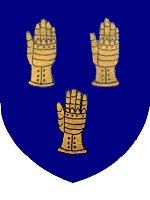 Thomas
Fane of
Brympton, later
Earl of
Westmoreland,
acquired the
Manor of Preston
Plucknett from
William Cox, a
timber merchant.
The manor passed
to his daughter,
Lady Georgiana
Fane in 1841.
Thomas
Fane of
Brympton, later
Earl of
Westmoreland,
acquired the
Manor of Preston
Plucknett from
William Cox, a
timber merchant.
The manor passed
to his daughter,
Lady Georgiana
Fane in 1841.
The arms are azure, three dexter gauntlets, backs affronty or (on a blue ground, three golden right-hand gauntlets with the backs facing the onlooker).
Owners and some tenants of the Manor, later called Preston Plucknett, are shown below -
|
1085 |
The Manor had been taken over from the Saxon thane Alestan after 1066 by Huigh Maltravers, Lord of Yeovil and Hendford. |
|
1150 |
William Fitzwalter, Baron of Haselbury, acquired the lands. |
|
1210 |
Richard, son of Walter, had succeeded but having been found guilty of treason against King John, was hanged at Sherborne, his estates confiscated to the Crown. |
|
1270 |
Haselbury estates, including Preston, granted by Henry III to John Marshall, nephew of the Earl of Pembroke. His son William was attainted for rebellion against the King, who seized the Manor again. |
|
1272 |
The Haselbury lands with Preston, bestowed on Alan de Plugenet, hence Preston Plucknett. (The other nearby Manor was by now known as Preston Bermondsey). |
|
1319 |
Alan's sister, Joan, inherited. She sold her estate, bit by bit, to John de Preston who assumed title of Lord of the Manor. |
|
1329 |
Death of John, his son also John succeeding. He died in 1361 his heiress being his daughter Elizabeth, wife of William de Pappeworth, who came into the Manor on her death soon after. He sold his estate piecemeal to John de Stourton who became the new Lord. |
|
c1400 |
John / Jenkyn Stourton inherited from his father, and by 1420 he had built himself a new Manor House and barn, as well as St James' church. |
|
c1438 |
Death of Jenkyn, followed by daughter, Cecily. |
|
1472 |
John Hill, son and heir of Cecily, Lord of the Manor. On his death two years later his grand-daughter Genosefa followed. She married Sir William Say who outlived her, owning the Manor. |
|
1529 |
On his death Sir William Say split the estate, bequeathing it to his four cousins; Thomas Hussey, William Clopton, Eleanor Babbington and John Walgrave. The Walgraves rapidly acquired the whole estate by purchase. |
|
1599 |
Charles Wlagrave by now owned at least all the former Stourton lands. The manor House was let to one Perry with 170 acres. |
|
1664 |
The House, now called Preston Great Farm, let to Anthony Ettrick. |
|
1725 |
Lord Waldegrave sold to Edward Phelips of Montacute. |
|
1758 |
Phelips sold the Manor to William Cox, timber merchant of Rotherhithe. |
|
1762 |
Thomas Fane of Brympton, later Earl of Westmorland, purchased the estate from Cox, William Andrews being the lessee of the Farm. |
|
1837 |
Thomas Hawkins - lessee of Farm from Westmorland. |
|
1841 |
Lady Georgiana Fane inherited the estate, together with half of Prince Edward Island in Canada, which she inspected personally. A very close friend of the Duke of Wellington, she had strong, if wrong, opinions about Preston. Convinced that her lands had once been monastic property she considered she should not pay tithes on the estate. First she changed the farm's name to Abbey Farm, since, she said, if it had not belonged to the Bermondsey Priory then it had been owned by the Convent of the Blessed Virgin Mary and St Bridget of Syon, Middlesex, since this House had held the Rectorship of Yeovil (with Preston) from 1418 to 1545. She started proceedings against the Tithe Commissioners to prove her point. She spent a fortune on lawyer's fees and after five years lost the case. The Farm had never been Abbey property, but the name has survived. |
|
1920s |
The Hawkins family bought the house and much of the land after the Ponsonby-Fanes had carried out some restoration as a consequence of a fire. Later, Hawkins sold out to the Hilbornes. |
|
1969 |
Bartlett Construction Group Ltd bought Abbey Farm and several fields and began improvements to the property. |
The Tithing of Preston Bermondsey
Preston Bermondsey was a separate entry called Prestetone in the Domesday Book, the name derived from the Old English 'preost tun' meaning priest's farm or settlement. It was quite small, with only nine households, and in the time of King Edward it had been held by Alward After the Conquest Ansger de Montagud held it directly from the king as well as being under-tenant to William, Count of Mortain for Houndstone. William was banished by Henry I and became a monk at the newly-established Cluniac Priory at Bermondsey. According to Vickery "In 1126 Ansgerius Brito, a descendant of that Ansger de Montagud who held this manor at the Conquest, gave Preston, consisting of two hides, to the Cluniac priory of our Holy Saviour of Bermondsey, to the intent that, with the profits thereof two chaplains might be found to celebrate divine service in the church of that monastery for the soul of the said Ansger, and the souls of his ancestors, and all the faithful deceased. This grant was confirmed by Walter Brito, or Bret, son of the said Ansger, and in 1193 the monks were found to have possessions here of the value of £8 3s 4d." From this time the tithing became known as Preston Bermondsey. The Priory held the land until the Dissolution at which time it reverted to the Crown.
It was sold in 1557 to a Thomas White and part of the estate was acquired by two brothers called Wakelyn in 1633 with the other part of the estate being bought by the Kymer family. The Kymer holdings were sold in 1672 to Joseph King and in 1677 the Wakelyn holdings were purchased by Henry Moore of West Coker.
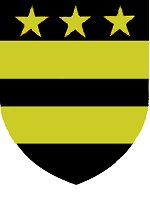 In
1705 Thomas
Freke of Bristol
bought part of
Preston
Bermondsey from
the King family.
Philip Freke
bought the
remained of
Preston
Bermondsey from
the Moore family
in 1709. Thomas
acquired
Philip's
holdings, and
other properties
between 1710 and
1716. An heir,
John Freke, sold
the manor to
John Butler in
1787.
The Freke family arms were
sable, two
bars or in chief
three mullets of
the last
(a black
ground with two
horizontal
golden bars, the
top third of the
ground - the
first of the
Ordinaries -
containing three
golden stars
representing the
rowels of spurs).
In
1705 Thomas
Freke of Bristol
bought part of
Preston
Bermondsey from
the King family.
Philip Freke
bought the
remained of
Preston
Bermondsey from
the Moore family
in 1709. Thomas
acquired
Philip's
holdings, and
other properties
between 1710 and
1716. An heir,
John Freke, sold
the manor to
John Butler in
1787.
The Freke family arms were
sable, two
bars or in chief
three mullets of
the last
(a black
ground with two
horizontal
golden bars, the
top third of the
ground - the
first of the
Ordinaries -
containing three
golden stars
representing the
rowels of spurs).
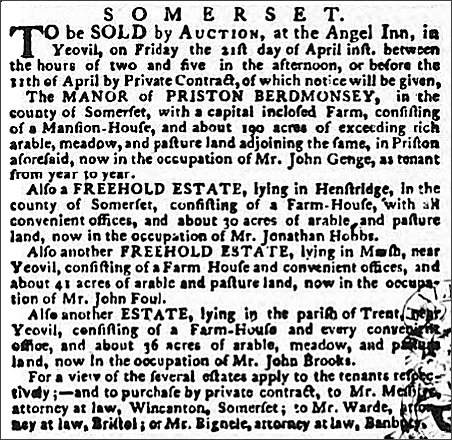
The Notice of Sale of Preston Bermondsey, and other estates, in the Salisbury & Winchester Journal's edition of 10 April 1786.
In 1856 Vickery wrote that the manor was then the property of John Wills. Preston Bermondsey ultimately became the eastern part of today's Preston.
The Tithing of Wigdon (East Marsh)
As noted above, after the Conquest the manor that was to become Kingston was held by tenant-in-chief Robert, Count of Mortain. This manor included the tithings that would become East Marsh and West Marsh. However Robert's son and heir, William, was banished by the king and the lands reverted to the Crown.
After these events Hugh de Say is the earliest recorded lord of this manor, probably succeeding his brother in 1184. The manor stayed in the hands of the de Say family until there were no further male heirs and the estate was divided between two sisters, Matilda and Edith, in 1226.
Matilda inherited Kingston and the tithing of East Marsh. Matilda was the wife of Thomas de Arderne who therefore became lord of Kingston as well as East Marsh.
By 1283 Walter de Wigdon was recorded as holding Kingston and East Marsh of Robert de Mortimer by "a knight's fee". Vickery observed "From the family of de Wigetone it came to the Fitzpaines, who held it by the service of half a knight's fee."
The Tithing of Huntley (West Marsh)
Following the division of the manor of Kingston in 1226, described above, Edith inherited 'La Marshe', or the tithing of West Marsh. Edith was married to Thomas de Huntele. who therefore became lord of La Marshe. By 1283 another Thomas de Huntley was recorded as holding West Marsh of Robert de Mortimer by "a knight's fee".
In 1324 John de Huntley sold the tithing to Walter de Tryl who settled it on himself, his wife and his daughter Joanna who was married to William Carent, and thus the tithing passed into the Carent family. In 1357 John Fawconer, of West Marsh, released to William, son and heir of William de Carent, then under age and in ward to the King, all his right in the manors of Kingston juxta Yeovil, and Hunteleghe-Marsh. From the Carents the tithing, by now known as Huntley, and part of the manor of Kingston, descended to the Stourton family, as described above.
It was separated from Kingston again in 1589 when it was sold to Joseph Compton of Newton Surmaville. It passed to Robert Harbin when he purchased Newton Surmaville in 1608.
The Manor of Lyde
 Lyde had its own
entry in the
Domesday Book with a total
of five
households and
in the time of
King Edward was
held by Godwin and Saeric.
The
post-Conquest tenant-in-chief
was
"Rogerius
Arundel",
thought to be
most likely a
kinsman of Roger
de Montgomeri,
and Azelin was
under-tenant. At
left the arms of
Arundel were -
sable, six
swallows argent,
3, 2, 1 (on a
black ground,
six silver
swallows, three
over two over
one). The family
were
considerable
land owners in
Somerset and
elsewhere.
Lyde had its own
entry in the
Domesday Book with a total
of five
households and
in the time of
King Edward was
held by Godwin and Saeric.
The
post-Conquest tenant-in-chief
was
"Rogerius
Arundel",
thought to be
most likely a
kinsman of Roger
de Montgomeri,
and Azelin was
under-tenant. At
left the arms of
Arundel were -
sable, six
swallows argent,
3, 2, 1 (on a
black ground,
six silver
swallows, three
over two over
one). The family
were
considerable
land owners in
Somerset and
elsewhere.
By the latter part of the twelfth century Lyde was held by Roger Fitzpayne by right of his wife, Margaret, who inherited through the line of her ancestor, Roger de Arundel.
Emorbus was the son of Brome Johnson who in 1576 received part of the Lyde manor/farm. Both Brome and Emorbus had extensive land holdings in Somerset. A deed dated 21 September 1576 recorded "To Adam Martyn, gent. and Robert Pytt alias Pyttman, to convey the fourth part of the manor or farm of Lwyde (Lyde) in Yeovil, to Brome Joneson alias Johnson."
Brome Johnson died about 1586 and another deed, dated 4 November 1587 noted "From the Crown to John Hoskyns, gent, of an annuity of £6 13s 4d to be assigned by the Master: etc., of the Court of Wards and Liveries from the Manors of Luyde and Bridge, with lands in Bridge, Southpetherton, Over Stratton, Compton, Durville, Deliewake, Sevinghampton alias Sevington, Dennys, Yevell, Wigheare alias Wigborough, Yvelton, Yvelchester and Woollavington, Co. Som. late Brome Johnson's who held from the Crown in chief and which have now fallen to the Crown on the latter's death by reason of the minority of Emorbus Johnson; together with the ward and marriage of the said Emorbus."
In 1611 Emobus married Alice Compton, daughter of Henry Compton of Wigborough. As a result of this marriage Emorbus obtained the manor of Lyde as a Marriage Settlement dated 20 January 1611 recorded "Of Emorb Johnson, of Bonram, Co. Wilts, esq. and Alice Compton, dau. of Henry Compton of Wigbearer, Co. Som. whereby the Manor of Lyrge alias Lyde, in Yeovil, and the third part of Wigbears Manor were settled on them."
By the marriage
of John Harris
to Elizabeth
Johnson (circa
1630), the
Harris family
obtained the
manor of Lyde at
Yeovil, as well
as other lands,
and the family
held the manor
until 1685 when
it was sold to
by John, the son
of John and
Elizabeth, to
William Helyar
of Coker Court.
John Harris, MP
for Liskeard,
the father who
married
Elizabeth
Johnson, was an
avowed royalist
and as such in
the early 1650s,
during the time
of Cromwell, he
was branded a
delinquent and
barred from the
House of Commons
with many of his
lands seized and
sold off. The
law did allow
for one fifth of
such lands to be
held in the
family for the
maintenance of
the children of
the so called
delinquents –
hence the
Somerset land at
Yeovil remained
with the Harris
family.
John died in 1649 and his son John inherited the Lyde property however he was faced with a permanent 10% fine, which was levied on all royalists and political opponents of Cromwell. This led to an uprising across parts of England in 1654 and persons involved in the resurrection were brought to trial. John Harris the younger, at the age of 23, was tried and confined for a time in the dungeons of Plymouth Castle, but was freed later. With his trial imminent and his future uncertain, John the younger proceeded by a variety of ways to place his properties in the hands of others – this included the sale of the Lyde property in Yeovil.
A Deed of Sale, for £3600, dated 1657 recorded "From Thomas Hele, of Fleet Damerell, Co.Devon Esq., son and heir of Sir Thomas Hele, Bart, John Harris, of Radford, Co. Devon, esquire, Jonathan Rashleigh, of Menabilly Co. Cornw. esquire, Jonathan Sparke, of Plymouth, esq. and Anthony Williamson, of Wenbury, Co. Devon, gent, to William Helyar, of East Coker, esquire, of the Manor of Lyuge al. Lyde, near Yeovil, Co. Som.Dated, 1 Jan. 1657".
Following the restoration of the monarchy in 1660 the lands confiscated but not sold were returned to the family – as the Lyde farm had been sold it was not returned.
In 1856 Vickery wrote "To the North of Yeovil is Lyde, formerly the estate of the families of Fitzpaine and Poyning."
The Manor of Newton
Although the manor of Newton, or Newton Surmaville as became known, was not described in the Domesday Book it had been created by the twelfth century by grant of the Crown. Leslie Brook wrote "It has been conjectured that Newton Surmaville.... was at one time part of the manor of Kingston, which separates it from Lyde.... there is a possibility that Lyde and Newton, both lying against the River Yeo, may have formed the two hides of Roger Arundel at the time of Domesday."
Daniel Vickery described Newton and its history as "situated near the banks of the river Yeo, and anciently called Newton-Sermonville, from the family of Sormarville or Sormayle, who possessed this manor and gave it their name. They were of Norman extraction, and, as it appears by the inquisitions and other records, held this manor by a very particular tenure. 1 Edward II (1272) Johanna de Sormarville held, in the village of Newton, then called Nyweton, a certain messuage, with a garden and sixty-six acres of arable land, half-an-acre of meadow, one acre of wood, and two acres of alder-grove, by the petty sergeanty of paying yearly into the exchequer, on the feast of St. Michael, a new table cloth, ten ells long, and a towel, five ells long, in lieu of all service.
In the time of Edward III (reigned 1327-1377) and Richard II (reigned 1377-1399) the family of Musket had considerable estates in Newton.
By an inquisition taken 14 Henry VI (1436) after the death of John Warmwell, of Newton-Sormail, it was found that the said John Warmwell died, seized of the manor, ; and that he was the son of Roger Warmwell, and by Margary, his wife, had issue, two daughters, Alice and Agnes, his co-heirs, between whom the manor was divided. Alice was married to Richard Penny, who dying without issue, she was married to her second husband, Simon Blyhe. Agnes was married to Ralph Brett, by whom she had issue, one son, who died child less. The said manor is certified to be held of the King, in capite, by the service of 6s 8d, a succedaneous equivalent for the towel and table cloth above mentioned.
The present proprietor of the manor is George Harbin, Esq., descended from an ancient family."
The Tithing of Houndstone
Houndstone had its own entry in the Domesday Book, referred to as Hundestone. With a total number of seven households, in the time of King Edward it had been jointly held by three thanes but post-Conquest Robert, Count of Mortain was tenant-in-chief and Ansger the Breton was under-tenant, probably the same Ansger de Montagud who held Preston Bermondsey above.